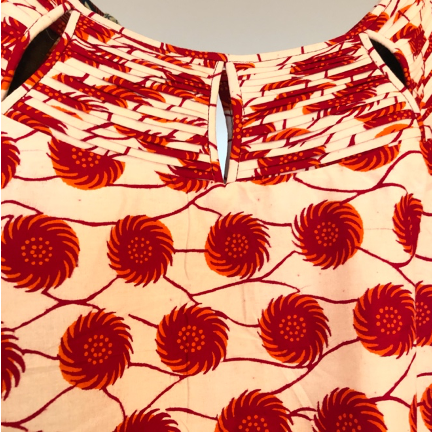West African fabric – a cultural celebration in color and texture
Nothing, and I mean NOTHING, quite gets to the heart and soul of a seamstress like new fabric. Especially new, never seen before fabric from another country! To say I was excited to visit Uniwax’s flagship store, Woodin, one of the preeminent fabric stores in Côte d’Ivoire (CI), is an understatement. After all, I’d travelled over 7,000 miles to get there (okay, so the trip was officially to pilot our Service, Learning and Lean-In tour, BUT…the FABRIC! So swoon-worthy).
As if an armful of amazing fabric from Woodin was not enough, we were then swept away to Alicia and Sekou’s tailor for fittings and garment design, another “pinch-me-I-must-be-dreaming” experience.
Ankara or Dutch Wax Print
Sandwiched between a butcher and sundry shop on a very bustling market side-street, with prêt à porter (ready-to-wear) clothing hanging out front, the tailor shop was alive with the hum of sewing machines and overflowing with design samples. We each had a turn being measured and talking though our design ideas with the head tailor, who made sketches and wrote our details into her order book – an art piece all its own, brimming with fabric swatches to correspond with orders.
All the finished garments were lovely and the perfect souvenir for an experience I will cherish for life.
Types of West African fabrics. As with many artifacts, fabric and its history tell the story of a culture – and Ivorian fabric does not disappoint.
Kente Cloth
Ankara or Dutch Wax Print – In CI, simply look in any direction and you’ll see beautiful and bold cotton prints in a variety of colors and patterns on the people parading by. Particularly charming was seeing entire families on New Year’s Day dressed in clothes made from the same fabric print. Development of Ankara fabric was influenced by Dutch batik – a method of dyeing cloth using wax-resist techniques – in the 1880s when trade ships landed in West Africa.
Historical prints that carry special meaning are particularly appreciated and sought after. Many wax prints have been used by the women of the country to communicate things such as marriage, fertility, personalities, home village, and special occasions. See Uniwax’s eye-popping fabrics and designs here.
Kente cloth – Typically woven in four-inch strips, then joined, this sturdy woven fabric features a variety of colors and geometric patterns and was originally worn only during very sacred times and by royalty. Woven primarily by men, patterns may represent one’s status and village, as we saw when meeting the Katiola region village chiefs. Kente patterns are an iconic representation of west African heritage, and is now prolific in clothing, accessories and home-goods. See Kente cloth being woven, here.
Mud cloth or Bògòlanfini
Mud cloth or Bògòlanfini – Similar to Kente cloth, mud cloth is also hand woven in narrow strips, primarily by men. Dating back to the 12th century and made from Malian cotton (Mali is the country due north of Côte d’Ivoire) its distinctive patterns and colors result from being dyed with fermented mud, its patterns created with bleach, then dried in the sun for a week. The mud is sourced from special locations and the dyeing process creates a variety of shades. Mud cloth has a rustic, organic, and earthy disposition – and its graphic patterns make for stunning home-goods. Learn more about Bògòlanfini here. See the dyeing process here.
Enjoy a bit of your own fabric from West Africa with one of our hypoallergenic face masks, which we are making and selling - with a portion of the proceeds going to our Ivorian charities.
Wear in good health! Erika
Get your Victory mask here!
*click to progress slide show

















